I’ve always been a fan of urban planning and city-building games since I was a boy. If I look deep enough within my house, I can probably find bundles of city maps, complete with streets, bridges, buildings, rivers – all drawn by my own hand. Besides the standard games on Miniclip and Coolmath that shaped my pre-tween years, the first flash games that I played included indie efforts at imitating SimCity games: laying power cables, water pipes, and roads; zoning residential, commercial, and industrial zones; and designating special areas for parks and recreation.
For me, there was just something about building livable cities that had everything a city required. Perhaps it gave me a sense of escapism from reality; or a sense of responsibility as a creator, an artist, or someone in charge; or just because laying down those roads and building the neighbourhoods was simply addicting to my young, growing mind.
So, when my friends introduced me to the game Cities: Skylines in the fall of 2015, I immediately knew that this would be the game for me. And indeed, by the end of the year, I had purchased the game and spent much time on it, working on my very first city.
Four years and more than 1000 hours later (rookie hours, I know), I can happily announce that Cities: Skylines remains at the top of my list of favourite games for all time. Plus, I’ve managed to find it even more addicting than Civilization V – which, as veterans know, might be the most common cause of accidental all-nighters. (Just one more round before bed… wait – it’s 6 am?)
That’s why, ahead of Cities: Skylines’s fifth anniversary, I’m pleased to provide you readers with a guide to the best, the worst, and the ugliest aspects of this game. If you’re already experienced with this game, then I’ll hopefully be able to induce some reminiscences of not only the things that draw you back into this game time and again, but also the things that make you want to “quit to desktop” and uninstall the game, never to touch it for as long as you’re on this Earth (but always eventually failing).
But what is Cities: Skylines?
If you still don’t know what Cities: Skylines is, even almost five years after its initial release, I truly pity you. You’ve been missing out big time. Cities: Skylines (hereafter referred to as C:S) is a city-building game made by Colossal Order, a game studio based in Finland, and published by Paradox Interactive, of grand strategy game (Crusader Kings 2, Europa Universalis 4) fame. It was released on March 11, 2015, during a time when the city-building gamer community was somewhat dissatisfied with the range of games then available in their favourite genre.
The most recent major game in the genre at that time was SimCity 2013, which was widely perceived by the community as being terrible. Upon launch in 2013, it suffered from network connection issues – a serious problem, given that the game required logging onto servers to be played. Moreover, players discovered tons of bugs and issues with path-finding, and didn’t appreciate how they were only provided with a 2 km-by-2 km plot to build their whole cities. (Well, let’s be honest – no fully-developed city in the world is that small.)

(from Reddit user /u/Yuzername)
Then came Colossal Order. The small studio wasn’t new to the world of planning: in fact, it had created two games (Cities in Motion and Cities in Motion 2) based around building transit systems. However, Paradox weren’t buying the idea of a city simulator game that would have to compete with the SimCity games – until SimCity 2013 came around and proved to the community that those games were no longer the gold standard for city builders.
There was now a serious demand for an even better city builder. Realizing from basic economics that high demand must always be met with supply, Paradox finally green-lit Colossal Order’s city builder idea. Hence, C:S officially entered the development phase, with the great aim of fixing what SimCity 2013 had royally screwed up and reviving the dying city builder genre.
Fortunately, unlike its competitor, C:S was critically praised, and it seemed as if the community would return to the era of high-quality city builders that ran smoothly and actually gave players the opportunity to build cities that were larger than 2 km by 2 km. Yet what was most surprising was that, compared to the large production teams of Maxis (SimCity 2013’s creator and part of EA), Colossal Order only consisted of a small team of nine people. Which goes to show that just because you have a small team, doesn’t mean you can’t outdo the competition. What’s also important is how passionate you are in your project and how incompetent the competitor’s production team is.
Getting into the Game
With the history of the game out of the way, it’s time to talk about the actual gaming experience.
So, let’s say you’ve started a new city. Welcome to Somewhere, USA, population 0.

(from my own screenshot library)
The first thing you’ll need to do for this empty city is plop down some power, water, and sewage. These are the foundation of every modern, sustainable city: without power, you wouldn’t be able to read this article on your device right now (because there’s no electricity to charge it or, and even worse, no Internet); without water, you’d either turn into a human raisin or go bankrupt from buying bottled water every day; and without sewage, you’d be forced to throw your waste from your window, into the street (just reading descriptions of old cities without complete sewage systems is enough to make anyone puke).

(from my own screenshot library)
With the basic necessities satisfied, you’ll need to lay down some roads, and build residential zones to allow people to move in and actually create a livable city. Follow this up with some commercial and industrial zones to give people jobs and the city a manufacturing industry that it’s proud to call its own.

(from my own screenshot library)
Now onto the citizen services. Add a police department here, a fire station there, and medical clinics, schools, and parks around the neighborhood; and you’ve created a society so livable, it would make the Joker proud (hopefully).

(from my own screenshot library)
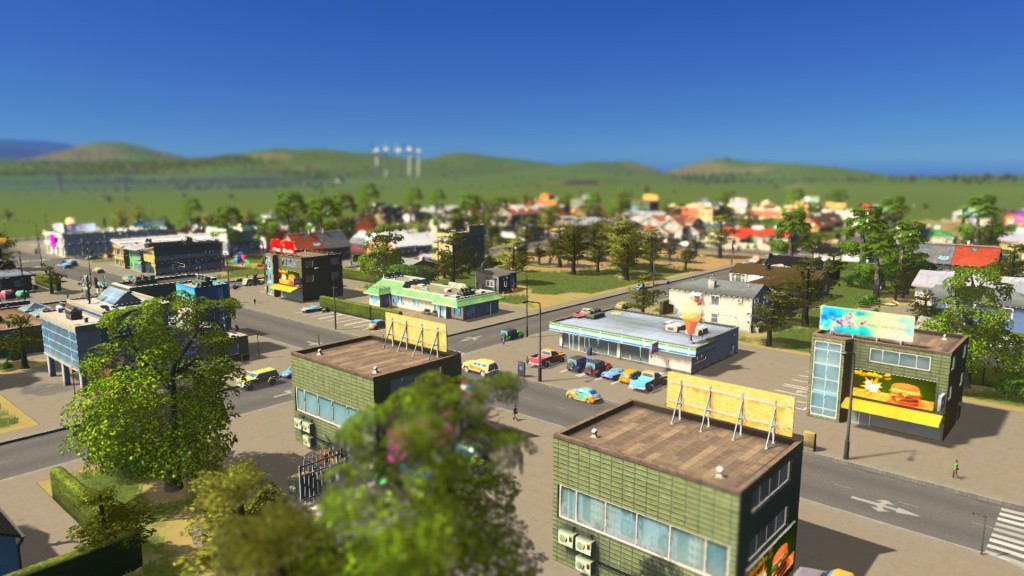
(from my own screenshot library)
Anyway, now that your city is prospering, you’ll be more than happy to see an influx of individuals and families moving into the city. These new residents will likely be coming over in their private cars or motorcycles. And with a rapidly growing number of cars on the road comes…
…oh God, the TRAFFIC!
Some people like to describe C:S as a city builder. Many others, however, would rather describe it as more of a “traffic manager.”
Because, for a great number of players, much of their experience with this game involves dealing with situations like this:

(from Paradox Forums user Lasch)
As in real life, cities in this game can also suffer from an abundance of traffic jams on very busy roadways, between the more bustling parts of town. If not dealt with early, it could ultimately cripple the city’s infrastructure, leading to sick people not receiving treatment on time and eventually dying, followed by hearses not being able to pick up the dead. The outcome of all this is that residences and businesses start becoming abandoned, since nobody wants to live in a city where untended bodies pile up on streets (what is this, the Middle Ages?).
Of course, much of this arises from poor road layouts on the part of the player, and it does take practice, along with an understanding of road hierarchies and where traffic comes and goes, to plan and manage layouts that can effectively transport vehicles from one end of the city to another.
However, frustratingly, it might also be because the game tends to act rather strangely, as in this example:

Here, we see traffic all merging from several lanes down to one main lane. You might expect all the traffic to be turning right (maybe there’s an event somewhere that everyone’s trying to get to), but, as Reddit user /u/PIGEXPERT complains, almost none of the drivers actually make a turn at the intersection.
If you visit the C:S subreddit, you’ll find people whining about this phenomenon, those who say it’s a bug that the developers just won’t fix for some reason, and those who defend it, consisting that it’s because the whiners just aren’t good at planning road layouts. But let’s be fair. If you’ve ever observed how traffic behaves in your own hometown, you’ll probably find that this does not happen AT ALL. At least, that’s what I’ve observed – and I’ve lived in and travelled to quite many cities in my lifetime.

(public domain)

(image from Wikipedia user Minesweeper)
At its worst, it’s probably enough to make you want to throw your keyboard at your monitor. If the city-building community had an aspect that would lead to a rage quit moment, this would definitely be it.
The solution, in this case, is either completely revamping the road layout, building public transit systems that cover much of the city, or downloading a couple of mods from the Steam Workshop that would help delineate where each lane would go and improve the path-finding ability of the in-game vehicles. Or just spend every day of your life complaining about it and hoping that the developers would fix it in the sequel.
Beyond the Basics
We’ll assume that, by now, you’ve gotten the traffic situation nailed down somehow. Now you’ll want to explore a little more of what the game can offer to further develop your dream city.
If you’ve gotten tired of the fact that your city is constantly creating pollution thanks to its industrial zones, then you can always transition your city to be based on the service industry instead by building more offices instead of industry. That’s another way to create jobs, but it does require a more educated workforce. So, be prepared to build universities to meet this increasing demand of educated workers.

(from my own screenshot library)
Alternatively, let’s say you wanted some nice statues to remind your citizens of their city’s glory. Or maybe a theatre or opera house for the citizens to find some entertainment of their own. Or even an aquarium for all the citizens – young or old – to spend their free time watching sea animals while also learning a bit about them at the same time. Of course, you can do all that in the game, as all of these are included as “Unique Buildings” that you can plop down anywhere in your city.

(from my own screenshot library)
If you’re willing to pay a little more, you can choose to download the game’s DLCs, which add a huge variety of features to your city. (Fortunately, unlike many games these days, you don’t need DLCs to play the game – they’re simply useful for aesthetic reasons.) These features include leisure and tourist districts, taxis, blimps, and monorails (and there’s nothin’ on Earth like a genuine bona-fide electrified six-car monorail! What’d I say?).
(from Reddit user /u/WVU_Benjisaur)
What’s more – just in case you’re still dealing with traffic problems and want to start your city all over again – the DLCs also provide the option to unleash natural disasters upon your city, like meteors, tornadoes, or tsunamis. Why spend money and time watching apocalypse movies at the cinema when you can bring upon apocalypses at home, by your own hand, while doing something you love? You can even customize how your city meets its demise – whether you’d like just one type of disaster or many, and how severe you’d like your disasters to be.

(from Reddit user /u/TheGoodVillainUK)
This is perhaps the moment where you’ll feel most like a god – capable of building metropolises from the ground up and creating utopias that will thrive for centuries, but equally capable of bringing it all to an end with a single, decisive, fateful stroke, like Sodom and Gomorrah from days long gone.
The Beauty of the Sandbox
Being in charge of your own city can indeed be a great thing.
Ultimately, this is what keeps bringing me back to the game – the ability to build your very own city that is designed exactly the way you want it to be. Once you get past the traffic management portion and manage to keep the city from falling into debt, the game becomes a sandbox, a canvas for expressing your own creativity and understanding of an ideal city. This is where you have the ability to build absolutely anything you wanted – even statues of Vladimir Lenin – without fear that you’d be overthrown by your citizens. They’ll just have to accept the fact that their mayor is omnipotent, omniscient, and omnipresent (sounds like someone we know from upstairs) – and move on with their lives.
And C:S is indeed an underrated way to display your artistic talent. Who knew that even roads could become a form of art? If you don’t believe me, just take a look how the community has managed to turn highway interchanges into beautiful, spaghetti-like networks of interconnected roads:
Or see what the community’s been doing with geometric road layouts here:

(from Reddit user /u/Anakeen)

(from Reddit user /u/whiterook6)
(from https://www.reddit.com/r/CitiesSkylines/comments/b4so7j/my_hexagonal_tesselation_city_hit_50k_this/)
And how could I forget the skylines? It’s literally in the game’s name!

See? This is the beauty of C:S – its sandbox nature gives players the opportunity to express themselves and build the ideal city of their own. When your life is consumed by the stresses of work, school, relationships, or society, you can always come back to the game for a dose of escapism and relief from the challenges of life. Once you start to get the chance to bring your creativity and ideals to life, you’d often never want to stop.
But what if I told you that you can go even further…?
Taking it to the Next Level with Mods and Assets
If you take a gander at the Steam Workshop, you can find a treasure trove of mods and assets that can very much revolutionize how you play C:S.
Let’s start with the mods.
Here, players of the game have listened to the community and created a plethora of mods that have proven to be great solutions to its concerns. Having problems with traffic AI that just won’t stop backing up on one lane of a six-lane road? There’s a mod for that. Want to build roads quite literally anywhere you want in the game? This is the mod you’ll want.
All in all, the mods give you so much more capability than what the vanilla game can provide. Here, you can truly become the master of your own city, with the ability to move buildings and roads pretty much anywhere you like, make traffic and population influx more realistic, or even to ignore all your city’s possible problems while you keep working on your skyline or fancy network of spaghetti interchanges.
After all, your citizens can’t hold demonstrations, launch coups against you, or assassinate you. You’re immortal and omnipotent. The only thing their piteous selves can do is complain on Chirper – their virtual version of Twitter – and hope that you would notice, read, or care about their posts. (And if you honestly don’t care about your citizens, you can even download a mod to ignore Chirper.)

Wait a minute. You work in the mining industry… and you’re complaining about MINING? That’s ironic.
(from my own screenshot library)
Another important part of the Steam Workshop to check out is the asset section. Here’s where you can find almost unlimited models of buildings (real and imagined), vehicles, and parks, among many others. If you ever wanted to make your very own city even more realistic and livable, you’ve got to check this place out. Personally, I spend too much of my time looking for and downloading assets, but it all pays off in the end when I see what they can do to improve the aesthetics of my city. (I’ll have to stop complaining about women being obsessed with shopping for clothes. Because I’m just as obsessed when “shopping” for mods and assets on the Workshop.)
Take a look at this screenshot of the skyline in one of my cities. Most of the buildings here come from custom assets from the Workshop.

Tell me whether these pictures below are real or screenshots from C:S made by members of the community:
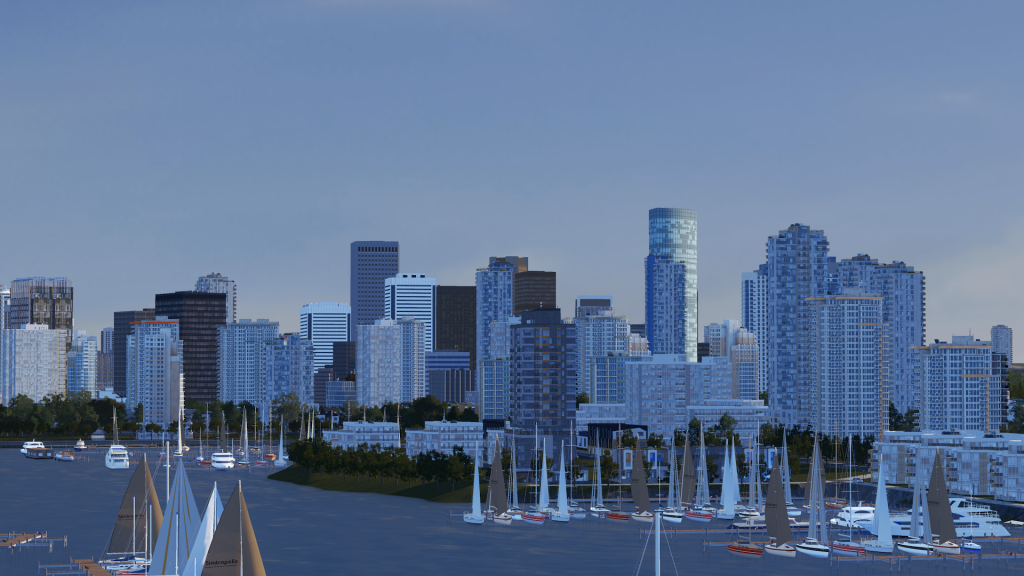
That’s the power of custom mods and assets: the ability to break the limits of what the vanilla game can provide you, and create beautiful skylines, vignettes, and scenes that make unsuspecting individuals believe that this is somewhere on Earth rather than a virtual, fictional location, stored as ones and zeroes in someone’s hard drive. Even I often can’t determine whether some of the screenshots posted on /r/CitiesSkylines (which is a subreddit explicitly made FOR C:S material) are from in-game or from real life.
In fact, mods and assets have played such a major part in the gaming experience that many in the community can’t envision ever going back to vanilla – or even having fewer than 50 mods and 2000 assets.
Of course, there’s a price to pay for all this. Loading mods and assets requires extra processing power from your computer, which causes it to take a pretty big toll. Not to mention the fact that the base game itself already consumes so much of your PC’s processing power to the point that a high-end CPU and graphics card are essentially unspoken prerequisites for the game. It’s common to have players build whole new PCs – CPUs, hard drives, graphics cards – just to play C:S.
You might as well say that the real cost of the game isn’t the $29.99 listed on online game retailers – it might actually be at least $1000, if we include how much money it costs to build a PC just for the full experience. But from all the almost-realistic screenshots I’ve seen from the community, I’m tempted to say that it will all be worth it in the end.
So, What Do I Think about this Game?
In conclusion, I would say that I’m absolutely hooked to this game, as my over 1000 hours’ play time can attest. (Notice my profile pic? Yep, that’s a screenshot from C:S.) Sure, it may suffer from terrible traffic AI, and it might cost a fortune just to build a PC that can efficiently run it, but there’s a certain creative potential that you can achieve while playing this game. And it’s that potential that ultimately brings me back into the game every once in a while.
In a world of stress and lack of control, it’s often comforting to find myself spending time creating a product of my own over which I can have complete say, and watching it slowly grow over time. Moreover, this is where I’m finally able to harness my long-standing interest in urban planning in designing my ideal city and see my ideals gradually come to life – even if virtually.
Furthermore, while playing 2000 hours on this game will certainly not be enough to make you immediately employable on an urban planning board, it would allow you to better appreciate the importance of the urban fabric in our daily lives. After all, once you start understanding how to build and manage a city, you might begin to see the beautiful and ugly sides of planning the cities that you live in. (Eventually, you’ll be able to gather your friends around on a night out and ramble about the biggest problems with your hometown’s urban planning, very much to their chagrin.)
All in all, Cities: Skylines is certainly a game that I would recommend to anybody – particularly to those people who are enticed by the idea of taking complete control, creating societies in their own image, and then possibly razing them down if they’re unsatisfied. Once you’ve conquered the learning curve and mastered managing your city’s traffic, there’s really nothing you can’t do, especially if you make the necessary sacrifice (for your PC, at least) and download mods and assets to spice up your gaming experience.
Because there’s honestly no better feeling than being in control of your very own Utopia.


